Why care about the places I visit? When I began my Substack Emerald City last year, I thought the answer was easy. There are certain “great interiors” long recognized in the annals of interior design for their architecture, decoration, furnishings and for the people who created them. These places are legendary to those in the know because they consistently spark creativity for the design that follows. Given the plethora of home enthusiasts out there, I presumed that readers of long form Substack content would appreciate learning more about great, legendary interiors and would enjoy seeing my pictures of them.
Fortunately, many of you do. Emerald City is steadily growing with each post even though I publish only when I have something new to share. My excuse for inconsistency: it takes time and money for me to visit notable interiors, photograph them, and dig deep into their place in design history—all before I pen my opening lines. Many thanks to those of you who indulge me by reading my tales of exploration (and discovery) as I report on important venues for your inspection. I am delighted you appreciate my work.
Having said this, I must tell you that as I scrounge around Substack looking for kindred spirits writing about interior design, I am often disappointed and begin to fear that my own efforts are the equivalent of “shouting into a void.” I uncovered reams of “home and lifestyle” postings that where either:
1. regurgitating stories already published by mainstream media (images included) and offering no additional editorial spin beyond the very basic “my favorite rooms of the month” piece; or
2. merely interested in selling product for purposes of accumulating more affiliate income.
These types of vapid posts are what tanked blogging back in the day in the first place. Often substackers of this variety have amassed huge social media followings elsewhere and are capitalizing on their successful “influencer” formula for short form posts in order to broaden their self-marketing reach on some new platform. Please save me from all these ‘Stacker’s weekly grabs for “likes” because that’s why Meta invented Instagram. Meta’s algorithm already throws tons of that sort of content in my face. I come to Substack for a bit more depth and inventiveness and I suspect you do too.
My concern mounted when Dennis Scully, the host of the leading podcast Business of Home, linked on his Instagram account to an essay by longtime, design industry creative consultant Sean Yashar. In it, Sean calls out the flattening of interior design to its lowest common denominator attributing that to the rise of social media design celebrities (aka “influencers”) who promote formulaic sameness. Sean is not wrong. We have become like sheep, casting “hearts” on whatever the algorithm puts in front of us. I don’t know when someone decided that buying all the same products and copying all the same rooms led to a stylish abode. Au contraire! It results in the boring and unimaginative. “Keeping up with the Jones” has never been interesting (except perhaps sociologically).
Dear reader, I am suggesting there is a better way. Sean thinks we should go back to the old days when the design industry “gate kept” the good stuff for the design trade. Really? That doesn’t align with my principles—I believe good design should be available to all. Lucky you if you have the desire and means to hire a professional designer. But if you don’t, or don’t care to, nothing should be off limits. Besides, it’s too late to gate keep: you can’t shut down the Internet.
You can, however, opt for the value of obtaining a solid interior design education. Please consider me a big cheerleader for that. As a freelance writer and an OG blogger who has written about design history and decorative arts on my blog (once called Decor Arts Now , and now Emerald City) for almost two decades, I can tell you that there is no need to return to school. This endeavor is ripe for a DIY if you are dedicated. I have two suggestions to that end that you can easily pursue on your own, and will surely improve how you feather your own nest in a manner that reflects you and only you.
First, read about historical design styles. Books should top your list and of course I hope you will continue reading my Substack. When it comes to magazines, I find that Frederic, Veranda and UK House and Garden regularly cover design history topics and feature homes that reflect that bent. Again, I believe interior design to be an art form that merits serious study, especially if you are interested in curating your own place so that it looks like no one else’s.
As you broaden your design reading horizons, you will discover that there is a rich framework extending back to ancient times and which still very much informs how to creatively decorate a room. The historical design movements, and the artisans, events and places that brought them to the fore, continue to be the source code used by today’s leading designers in creating new and innovative interiors. Designers don’t copy the old styles verbatim but rather fold design history into their tool kit. The traditions are very often powerful launch pads.
Not sure? Here are just a few examples. Celerie Kemble practically broke the internet this month when Architectural Digest published her new apartment with its statement-making adornments drawn from the Baroque period intermingled with her other more contemporary furnishings. Summer Thorton knew that Charleston was not only a city in South Carolina but also an inspiring farmhouse in England when she created a cheerful home office that riffed on the Bloomsbury Group . Then there is Martyn Lawrence Bullard who fashioned a second Print Room in Ireland inspired by the only other one extant there dating from the 1760s. Architect Peter Pennoyer and his designer wife Katie Ridder regularly collaborate to create homes steeped in neoclassical architecture by Peter and adorned with Katie’s bold choices in color, textiles, tiles and antiques that span the world from Japan to Morocco both exemplifying the finest in global design traditions. The home they built for themselves from the ground up in Millbrook, NY is a perfect example. Finally, when Miles Redd creates the richly layered rooms he is known for, he draws upon the great estates of the 18th and 19th centuries that display the treasures from their aristocratic ways of life—including artifacts from their Grand Tours. I try to spice my newsletters with myriad antecedents of these kinds of contemporary homes.
Second, if you want your home to be unique, please (!), turn off your computer, shove aside the glossies, and go outside. No joke, nature is the ultimate fodder for fine design.
Another surefire way to further your design education (including the individuality and connoisseurship that comes from it) is to attend art exhibitions, antique shows and design trade fairs in your area. The color palettes of so much fine art provide terrific inspiration when it comes to deciding what hues with which to color your rooms. That’s why I occasionally depart from interiors and cover an art exhibition in Emerald City. As for design trade fairs and antique shows, the more you visit and examine carefully, the more developed your own eye becomes. You’ll find that the design purchasing decisions you used to puzzle over will be managed far more adeptly and easily. Lastly, visit great interiors yourself. There are historical house museums most everywhere. You will love the feeling of internalizing design vocabularies and knowing what makes a room timeless.
Earlier I mentioned the irony of finding Sean Yashar’s provocative Substack essay on Instagram via Dennis Scully. As you may know, Substack, unlike any other media outlet, does not recognize the “shelter” vertical. This hinders the discovery of good newsletters discussing brilliantly thought-through interior design. Instead Substack offers an overly-broad category dubbed “Design” that jumbles all sorts of far flung topics (such as UX Design) that while interesting in other contexts, have nothing to do with homes and gardens.
After my deep dive in search of other “shelter” substacks left me wanting, I wondered if the dearth of original content in this niche I find so important, is why the Substack platform hasn’t granted it a category. If you made it this far in my essay, please let me know what you think of this theory.
Of course, I must shout out some wonderful exceptions. Plug “home” into the Substack search box and up pops Kate Watson-Smyth’s “Mad About the House,” and rightly so. She has been a writer and journalist for more than half her life and started her blog (now on Substack) more than a decade ago. She offers informed, practical advice on putting together a beautiful home by breaking the elements down to the nitty gritty (i.e., the basics). Then there is Laura Fenton of “Living Small.” Laura is a small-space and sustainability expert whose well-researched and insightful posts tackle those issues. I can’t help but wonder if she would like to see the teensy, tiny home I wrote about that Frank Lloyd Wright designed on a budget for a middle class family. After all, Laura specializes in living small. I also was delighted to find “The Design Release” where a trio of industry insiders report on design exhibitions and fairs so that you can discover local ones to attend. Finally, I am enjoying the newly launched “Second Story” by Robert Khederian for lovers of old houses and history, personal delights of mine.
All of these newsletters feature original essays that steer clear of self-aggrandizing listicles aimed at monitization. I am certain there are more of you out there like me, and, if by some bizarre coincidence you are reading this post, please say ‘hi.’ I want to be friends. Maybe when we emerge as a distinct and populous group of original design content creators, Substack will take notice and freaking give us a category!
Ok, enough proselytizing. I promise that next time, I’ll return to my usual form and give you a tour of one of the most “influential” (in the old sense of the word) homes in the history of interior design. I traveled to France to see and document it, and I can’t wait to share what I saw.
This isn’t a one-way rant. Please let me know what you think of this post. Are you by chance like me—concerned that as Substack becomes ever more popular, the banality that often floods the web elsewhere will infect the interior design content on this platform? Maybe I am crazy-wrong? If you think so, please tell me, or alternatively, tell me what you think of the state of interior design today. Is Sean right? Was quality higher and more innovative when professional designers controlled the reins? I would love to hear from you.
À la prochaine voyage,
Lynn
Photography Credits
As my regular readers know, my own photos generally dominate my newsletters, but this time I am including images of the spaces I mentioned above, with sources noted, to show how knowledge of historical styles and the history of interior design remain relevant today because they spark great new work. You need to know the rules, to break them.
Thank you to Miles Redd for providing me with the first image above. It depicts a beautiful apartment on Central Park West steeped in color theory designed for an artist friend of mine.
Below, are a few photos of Celerie Kemble’s new apartment published by Architectural Digest in February 2025, photographed by Kelly Marshall. It’s all over Instagram, where these photos come from. A good tapestry was all the rage back in the Baroque period. So were dramatic, over-scaled S-scrolls in home furnishings, like the curvy elements on the fireplace mantle. I can just make out a couple of stylized sunburst mirrors in the last photo of Kemble’s living room flanking the windows. The Sun King (Louis XIV), ruler of France and the Baroque, used sunburst motifs all over Versailles.
Below, Summer Thorton may well have designed the most cheerful home office of all time when she channeled the painted decoration at Charleston, the farmhouse in Sussex, England frequented by members of the Bloomsbury Group. Photograph by Thomas Loof and featured in Veranda Jan/Feb 2025. (Image source: Instagram)
Below, I’m drooling over Martyn Lawrence Bullard’s print room for Capard House in Ireland modeled after the one in Castletown House that he posted on his Instagram that was also published in Veranda. Photos by James Mcdonald.
Below, Peter Pennoyer and Katie Ridder’s Millbrook home combines gorgeous neoclassical architecture with a bold color scheme and global finds that remind me of some of the eclectic Portuguese interiors I saw last year that stemmed from that country’s early explorers. Images from their websites.
Below, one more from Miles Redd that looks just like a great English country house. Published in Veranda Jan/Feb 2024 and photographed by Noe Dewitt, it’s a reboot of Bunny Mellon’s private gallery, Brick House, in Virginia. Photo sourced from the Redd Kaihoi Instagram.
Further reading






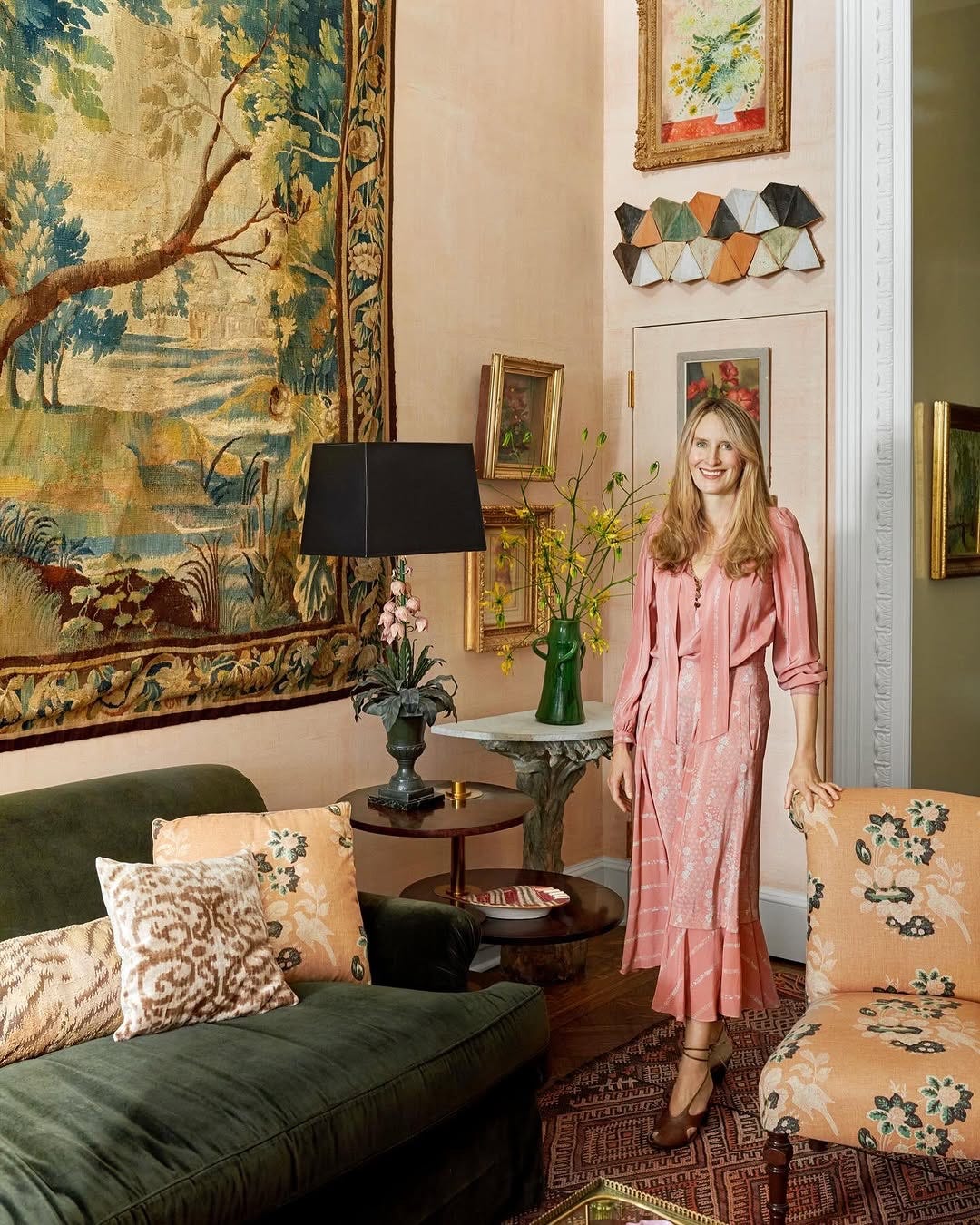

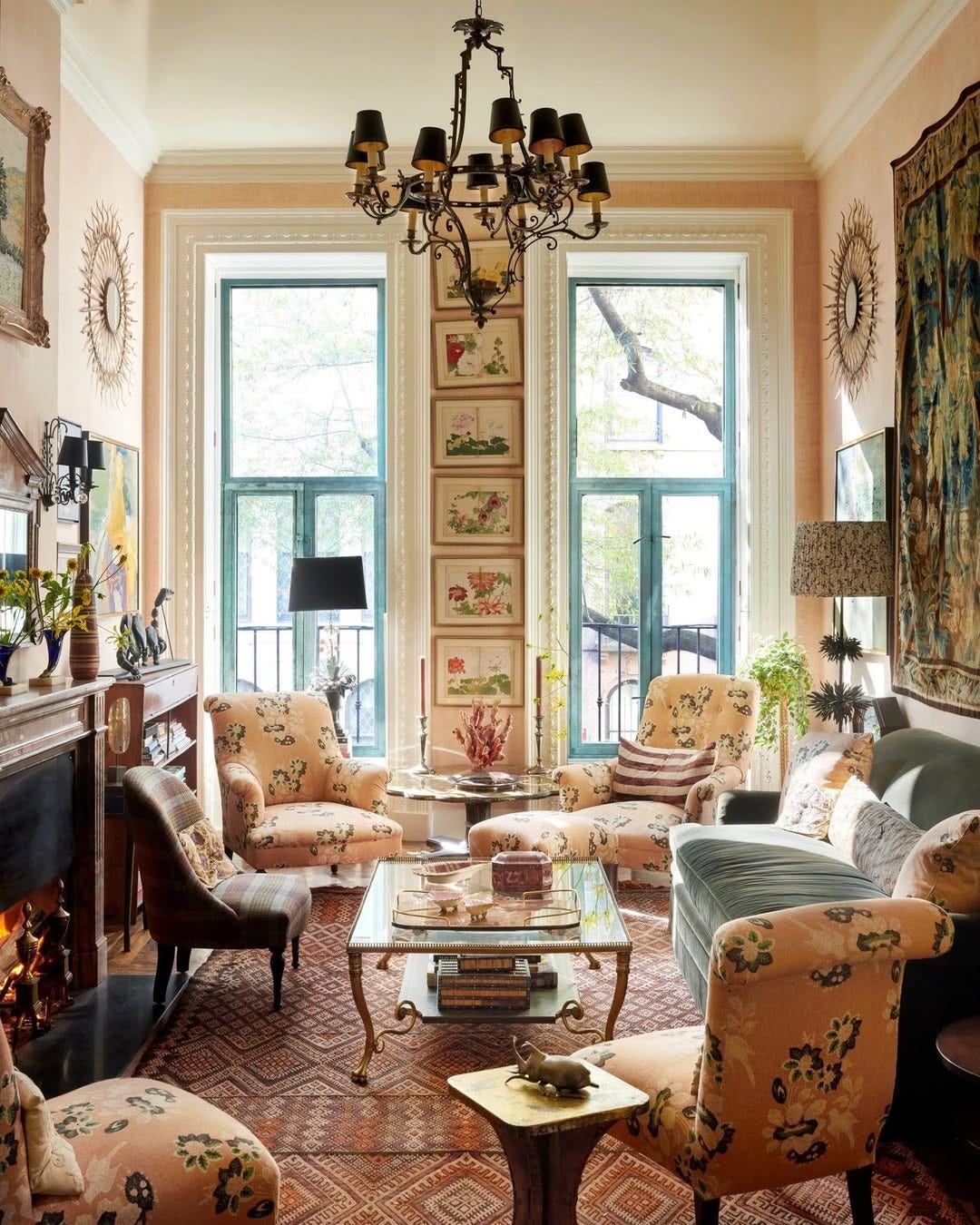
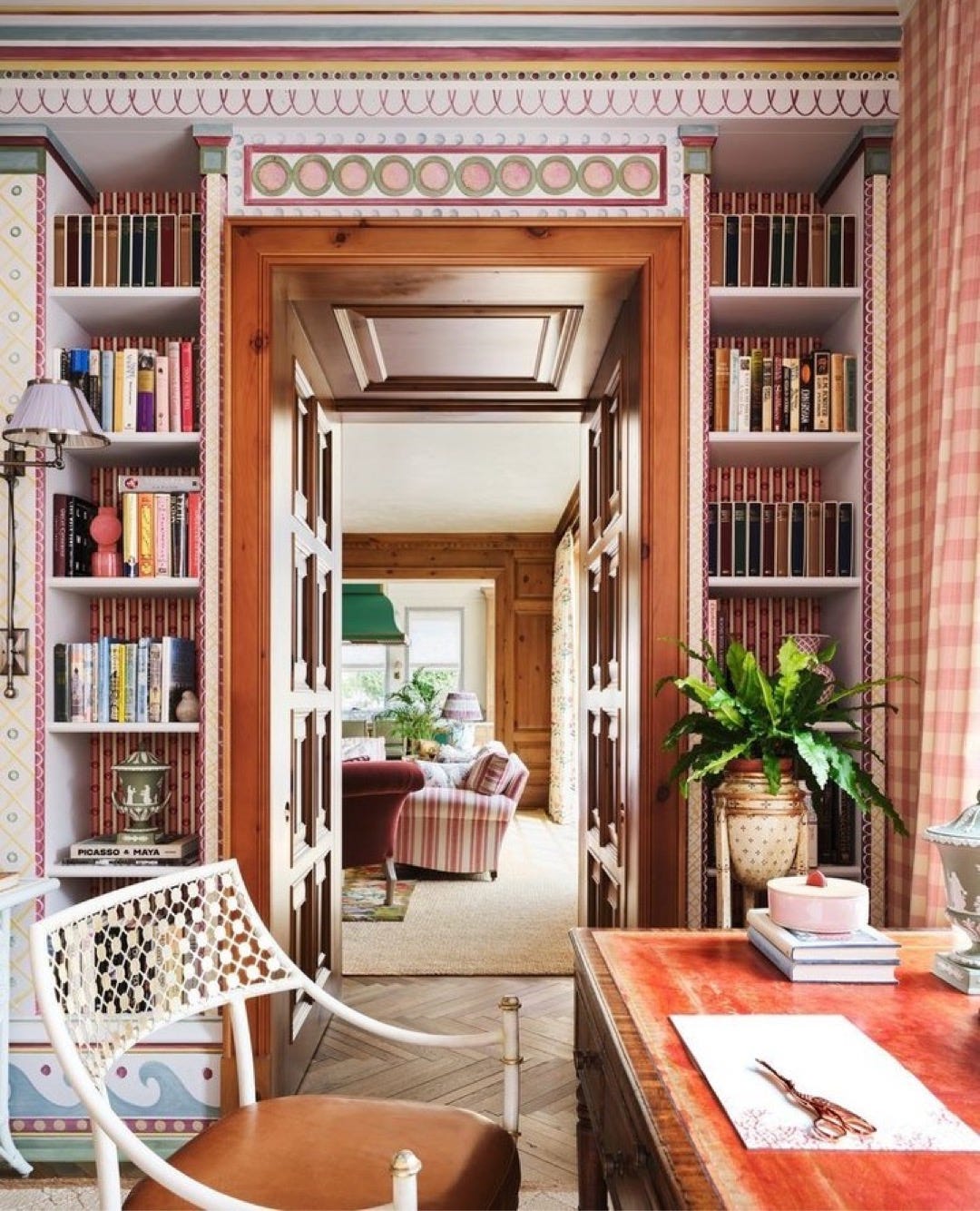

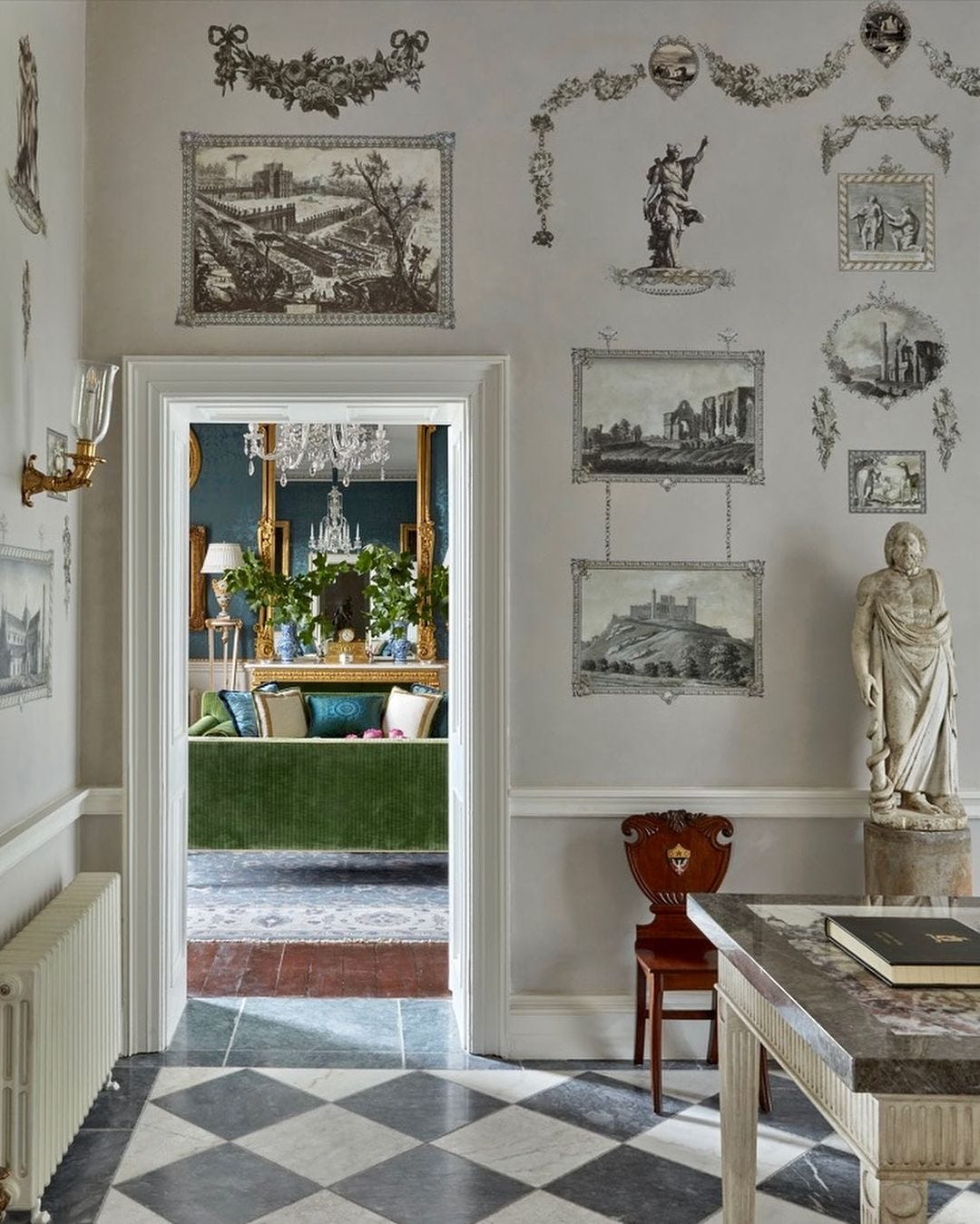
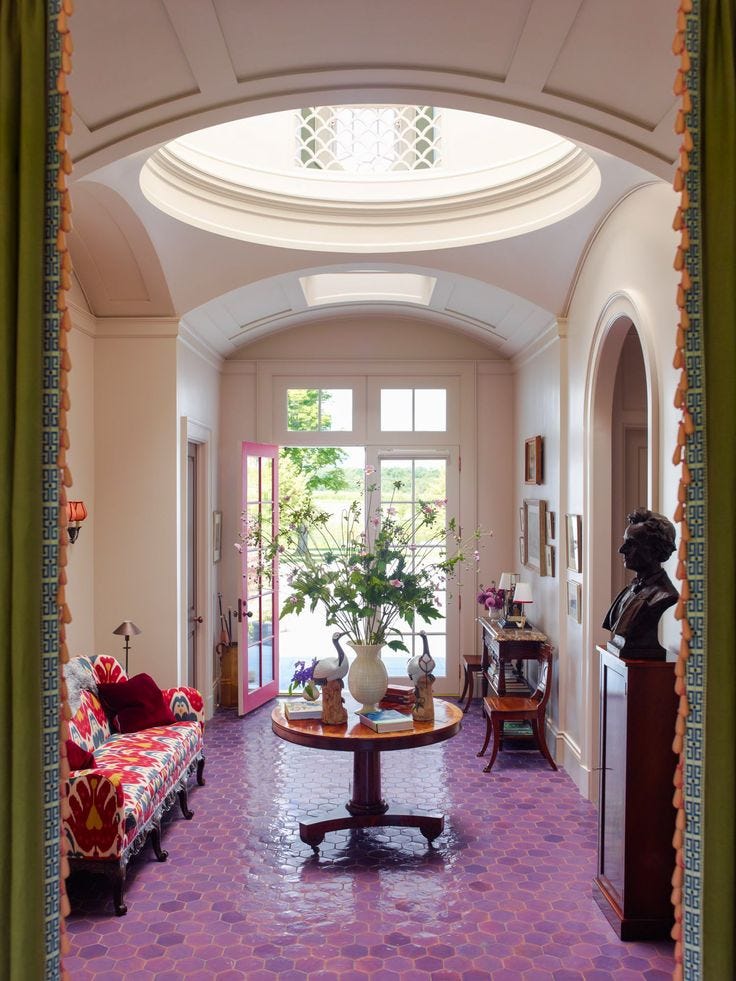

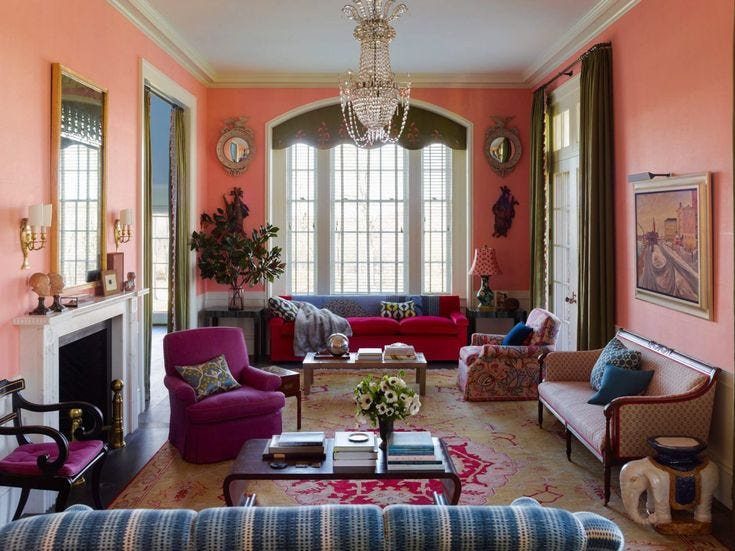
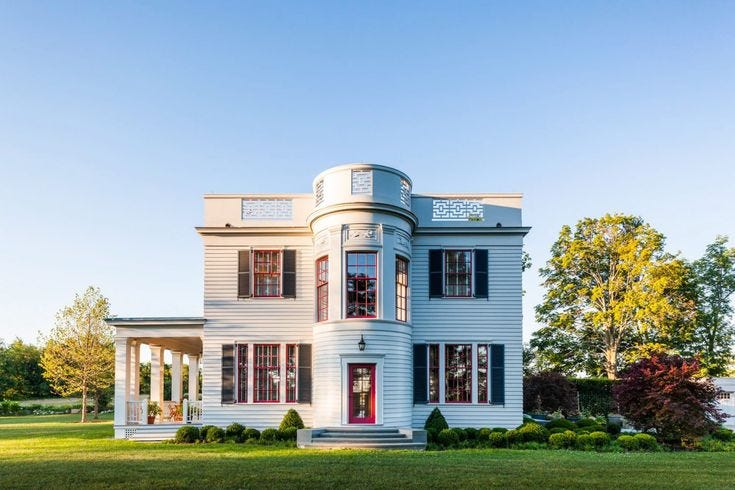
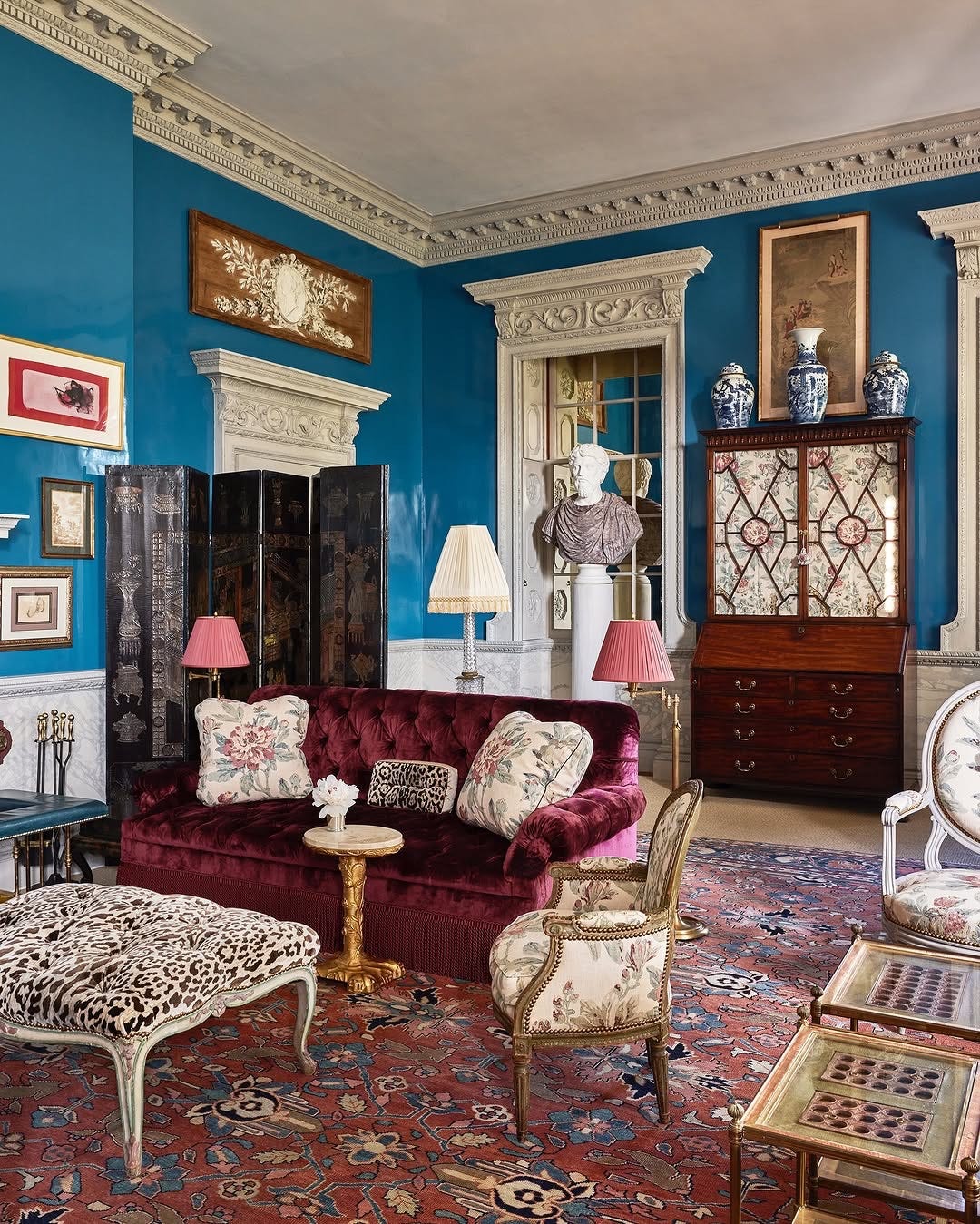
I am a former garden designer, and studied architecture in the 1980s. I LOVE the field of design, no matter if it's exterior or interior. What I find crushing these days is reading an article on the internet about the new trend in color, or counter tops, etc. The script is accusatory sometimes and the photos appear so soulless, and, if you've just finished your new kitchen, it must be gutting to discover that "experts" think it's now out-dated. I agree very much with the idea of studying the design, art, and architecture of the past, and then acknowledging to oneself what moves you personally, both esthetically and in your soul. Do "you", but make sure you actually have enough knowledge to truly know what is out there, and truly makes your statement. Don't just copy something because everyone says it's the latest thing.
Lynn, I enjoy your thoughtful, thorough Substack articles and they are sui generis on the platform. Due maybe to lack of a category, also maybe due to an impression Substack is not visual--a forum for essays and argument, even though it handles photos fine and they promote videos. I'm glad it's not yet a crowded scene of bland, monetized content as blogging became.
On the dispiriting sameness in interior design as seen on the internet, it feels like there are many causes. The democratization of design that Sean Yashar discusses is an element, but I don't think you can turn the clock back to the rarefied elite past (and I don't wish a return. People deserve to live with good design and our culture already affords too much deference to big wealth.) Yashar's point on the ill-effects of Design Entertainment is spot on. I blame HGTV for an avalanche of gray, black and white cookie cutter "design", and for the horrid "remuddling" of older residences seen on the insta We Prefer The Before.
So much online content is about DIY at the lowest common denominator. Showing:
-no understanding of design history or principles
-no appreciation of connoisseurship
-a quick hunt for attainable fakes over authenticity
-often a fear of color
-a promotion of copying a "look" rather than individual creativity and expression
-no understanding of inspiration and influence vs imitation
-a terrible emphasis on a speed-cycle of trend vs "datedness" (financially wasteful and hard on the environment)
Some "pros" are in on this. We just moved to Seattle and when shopping for a condo I wanted to strangle the stagers who all seem to follow one dreary recipe. (I know staging has different aims, but still.... haha.)
It's not all bleak - there are inspiring images and people online who make it clear what good designers can do. There IS more access to quality and inspiring things to see if you search.
Sorry this got so long! Few will read it all, but the topic winds me up! The democratization of design could have meant the extension of good design to far more people, but hasn't turned out that way. You're exactly right that the antidote is taking time to educate yourself about design (whether you plan DIY or to hire a designer) and your list of suggestions on how to do that is excellent!